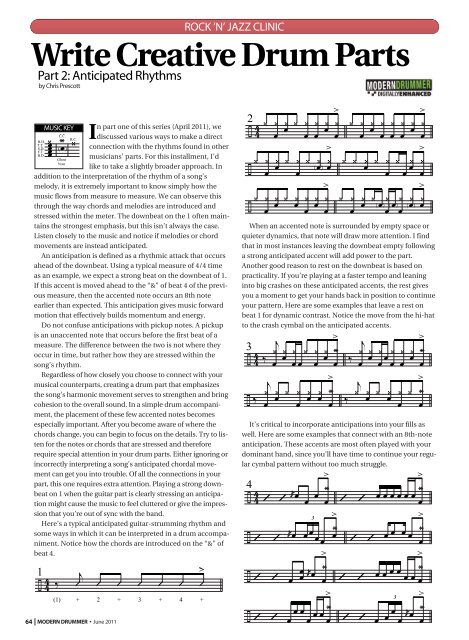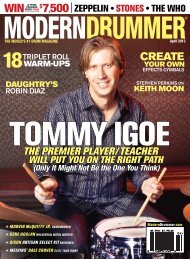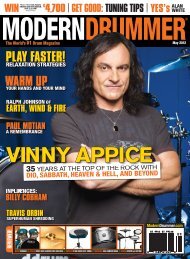" 1FSGFDU $JSDMF 1BSBNPSF 8FF[FS %FWP - Drummers.by
" 1FSGFDU $JSDMF 1BSBNPSF 8FF[FS %FWP - Drummers.by
" 1FSGFDU $JSDMF 1BSBNPSF 8FF[FS %FWP - Drummers.by
You also want an ePaper? Increase the reach of your titles
YUMPU automatically turns print PDFs into web optimized ePapers that Google loves.
64<br />
I<br />
MUSIC KEY<br />
n part one of this series (April 2011), we<br />
discussed various ways to make a direct<br />
connection with the rhythms found in other<br />
musicians’ parts. For this installment, I’d<br />
like to take a slightly broader approach. In<br />
addition to the interpretation of the rhythm of a song’s<br />
melody, it is extremely important to know simply how the<br />
music flows from measure to measure. We can observe this<br />
through the way chords and melodies are introduced and<br />
stressed within the meter. The downbeat on the 1 often maintains<br />
the strongest emphasis, but this isn’t always the case.<br />
Listen closely to the music and notice if melodies or chord<br />
movements are instead anticipated.<br />
An anticipation is defined as a rhythmic attack that occurs<br />
ahead of the downbeat. Using a typical measure of 4/4 time<br />
as an example, we expect a strong beat on the downbeat of 1.<br />
If this accent is moved ahead to the “&” of beat 4 of the previous<br />
measure, then the accented note occurs an 8th note<br />
earlier than expected. This anticipation gives music forward<br />
motion that effectively builds momentum and energy.<br />
Do not confuse anticipations with pickup notes. A pickup<br />
is an unaccented note that occurs before the first beat of a<br />
measure. The difference between the two is not where they<br />
occur in time, but rather how they are stressed within the<br />
song’s rhythm.<br />
Regardless of how closely you choose to connect with your<br />
musical counterparts, creating a drum part that emphasizes<br />
the song’s harmonic movement serves to strengthen and bring<br />
cohesion to the overall sound. In a simple drum accompaniment,<br />
the placement of these few accented notes becomes<br />
especially important. After you become aware of where the<br />
chords change, you can begin to focus on the details. Try to listen<br />
for the notes or chords that are stressed and therefore<br />
require special attention in your drum parts. Either ignoring or<br />
incorrectly interpreting a song’s anticipated chordal movement<br />
can get you into trouble. Of all the connections in your<br />
part, this one requires extra attention. Playing a strong downbeat<br />
on 1 when the guitar part is clearly stressing an anticipation<br />
might cause the music to feel cluttered or give the impression<br />
that you’re out of sync with the band.<br />
Here’s a typical anticipated guitar-strumming rhythm and<br />
some ways in which it can be interpreted in a drum accompaniment.<br />
Notice how the chords are introduced on the “&” of<br />
beat 4.<br />
MODERN DRUMMER • June 2011<br />
ROCK ’N’ JAZZ CLINIC<br />
Write Creative Drum Parts<br />
Part 2: Anticipated Rhythms<br />
<strong>by</strong> Chris Prescott<br />
When an accented note is surrounded <strong>by</strong> empty space or<br />
quieter dynamics, that note will draw more attention. I find<br />
that in most instances leaving the downbeat empty following<br />
a strong anticipated accent will add power to the part.<br />
Another good reason to rest on the downbeat is based on<br />
practicality. If you’re playing at a faster tempo and leaning<br />
into big crashes on these anticipated accents, the rest gives<br />
you a moment to get your hands back in position to continue<br />
your pattern. Here are some examples that leave a rest on<br />
beat 1 for dynamic contrast. Notice the move from the hi-hat<br />
to the crash cymbal on the anticipated accents.<br />
It’s critical to incorporate anticipations into your fills as<br />
well. Here are some examples that connect with an 8th-note<br />
anticipation. These accents are most often played with your<br />
dominant hand, since you’ll have time to continue your regular<br />
cymbal pattern without too much struggle.





